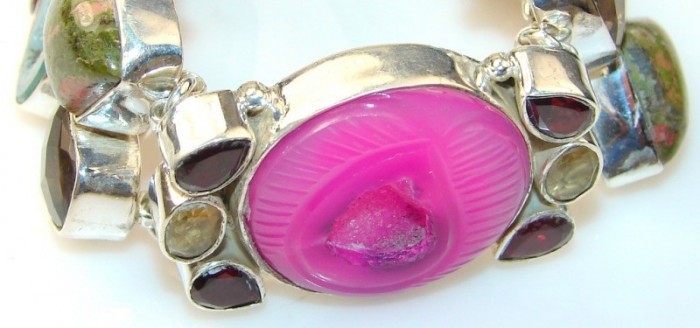How Are Synthetic Gemstones Made And How Are They Different?

Nothing can really compare to the natural beauty of real gemstones that have been shaped and worn down by nature and later cut and polished to become beautiful jewels to wear or for decoration. However, it is common for more and more jewelers to sell synthetic gemstones to customers at a lower price than a natural gemstone would cost, much lower because of the process of how they are made.
It can be common knowledge that synthetic gemstones are created in a laboratory but just how exactly and how can you tell the difference between a synthetic gemstone and a natural gemstone? If you walked into a jewelry store, would you be able to tell the difference between the two different gemstones if no description was included to tell you which one was real and which one was synthetic?
How to Create a Synthetic Gemstone
The process to create a synthetic gemstone is fairly easy and cheap because the gemstones are grown and manufactured in a controlled laboratory environment where they can mass produce the gemstones. A common synthetic is to use cubic zirconia as a diamond simulant along with using dyed glass or plastic to create a gemstone.
According to the Federal Trade Commission, each gemstone needs to include detailed information that explains to the purchaser that the gemstone is not natural and how it was exactly created. The statement needs to be worded in such a way that it is obvious that it was created in a laboratory and not naturally so it is not deceiving. Besides the FTC, other organizations have similar guidelines that need to be followed:
- American Gem Trade Association (AGTA)
- International Colored Gemstone Association (ICA)
- World Jewelry Confederation (CIBJO)
To create a synthetic gemstone, there are two main processes: melt or solution. For the melt process a flame fusion/verneuil process or crystal pulling/czochralski process is done. The flame fusion process is common for the creating of rubies, sapphires, and diamond simulants. Starting materials such as alumina, oxides, and titania are crushed to a powder. The powder is then placed in a Verneuil furnace so that the heated powder creates liquid droplets that cool as the synthetic material is then shaped by a cylinder.
The crystal pulling process creates synthetic gemstones by first placing a movable seed crystal above a melted liquid solution. A growth mixture is added to the iridium crucible that includes aluminum oxide or other aluminum oxides for a specific color. The seed crystal is placed at the surface of the heated liquid and then slowly withdrawn while being rotated at the same time. After coming into contact with the heated liquid, a crystal grows from the crystal seed.
The solution process to create a synthetic gemstone has two main processes as well: flux growth or hydrothermal growth. For the flux growth to take place, components of the desired substance are dissolved in a solvent called flux.
Using controlled furnaces, non-reactive elements such as:
- Platinum
- Tantalum
- Niobium
and more common materials that are similar for the other creation processes including:
- Alumina
- Zirconia
- Boron Nitrade
After the solution is cooled, the crystal needs to precipitate but are often quite small.

For hydrothermal growth a solution of minerals in hot water and under high pressure to grow synthetic crystals. The pressure is caused by a steel pressure vessel called an autoclave. In the meantime, opposite temperatures are used in the growth chamber with one side hotter to dissolve the solution and the other end is cooler to help the seeds grow.
How to Tell a Natural Gemstone from a Synthetic Gemstone
Now that you know the different processes to create a synthetic gemstone, how will you be able to tell the two gemstones a part? It’s quite easy to tell the difference between the two if you know the signs.
1. Appearance of the gemstone
Natural gemstones will have obvious flaws and scratches for the outside elements where as a synthetic gemstone is flawless because it was created in a controlled environment. Natural gemstones will also have rough edges that need to be cut down and polished and therefore will not appear to have so much shine because they are worn down by the natural elements but synthetic stones will sparkle.
2. The weight of the gemstone
A synthetic gemstone will weigh more than a natural gemstone because they are denser. Also, synthetic gemstones can be made to be any size but natural gemstones can only be found as certain sizes of gemstones depending on the size of the vein and the mine. If a gemstone that is known to be small in size is being sold at a much higher carat, then most likely it is a synthetic gemstone that the jeweler is trying to sell.
3. The price of the gemstone
Synthetic gemstones will be more moderately priced than real gemstones because of course those are rare and thus more valuable.
It is up to you if you wish to purchase a natural or synthetic gemstones, but now you know exactly how your synthetic gemstones are created and you can easily distinguish them in stores when shopping for a gemstone. If you are not quite ready to make an investment in purchasing a natural gemstone, you can still consider purchasing synthetic gemstones. With the different processes, you can purchase almost any different type of gemstone to add to your collection.
You may also like ...
- Looking Back at All of Your Years Together: Why Traditional Gemstones Commemorate Wedding Anniversaries
- How Does A Gemstone Appraisal Work?
- Just How Well Will A Jewelry Cleaning Recipe Work? The Best Methods To Try To Clean Gems At Home
- The Most Valuable Gemstones You Never Knew Existed
- What You Don’t Know About Silver: It’s Antimicrobial?!
- Earrings - how to choose the perfect pair for yourself?













